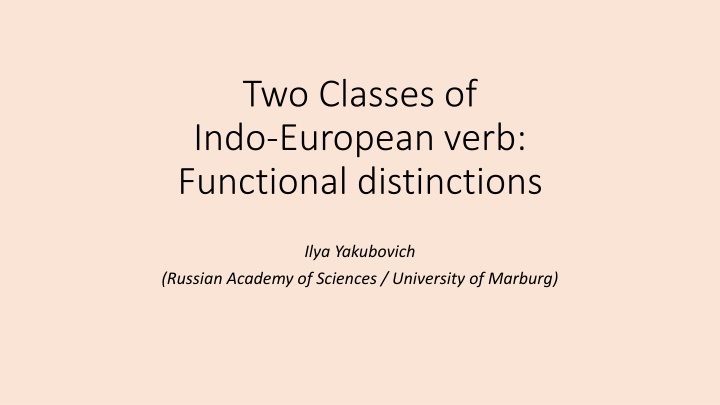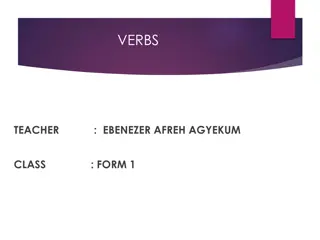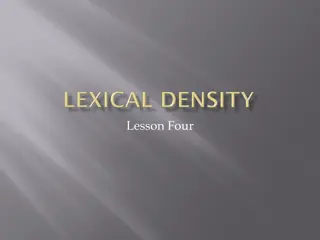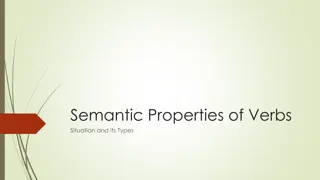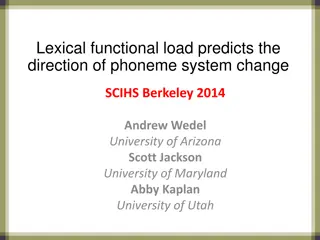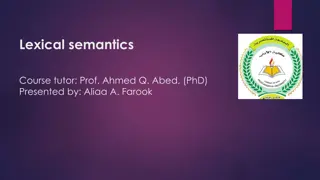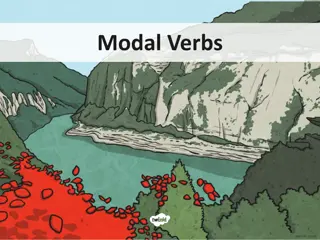Functional and Lexical Distribution of Indo-European Verbs
Investigating the functional and lexical distribution of Indo-European verb classes, this research delves into the mi- and xa-conjugations in Proto-Indo-European, new discoveries in the preterit of the xa-conjugation, paradigms in Hittite, perfect and middle endings in Late Indo-European, and the challenges posed by lexical and functional distributions. Examining suppletive and perfecto-present verbs, the study highlights the complexities of Indo-European verbal classes.
Download Presentation

Please find below an Image/Link to download the presentation.
The content on the website is provided AS IS for your information and personal use only. It may not be sold, licensed, or shared on other websites without obtaining consent from the author.If you encounter any issues during the download, it is possible that the publisher has removed the file from their server.
You are allowed to download the files provided on this website for personal or commercial use, subject to the condition that they are used lawfully. All files are the property of their respective owners.
The content on the website is provided AS IS for your information and personal use only. It may not be sold, licensed, or shared on other websites without obtaining consent from the author.
E N D
Presentation Transcript
Two Classes of Indo-European verb: Functional distinctions Ilya Yakubovich (Russian Academy of Sciences / University of Marburg)
Structure of the Talk Structure of the Talk 1. mi- and xa-conjugations in PIE: Status quaestionis 2. Preterit of the xa-conjugation: New formal discoveries (largely based on K mmel 2018). 3. Interpreting the new empirical results in functional terms.
Paradigms of Hitt. pai- go and da- take mi-conjugation i-conjugation singular plural singular plural present 1 p imi p iwani d i tum ni 2 p i i p ittani d tti datt ni 3 p izzi p nzi d i d nzi preterit 1 p un p iwen d un d wen 2 p i p itten d tta datten 3 p it p (i)er d d er
Perfect and middle endings in Late Indo- European (Jasanoff 2003: 55)
Two Indo-European conjugations: between function and lexicon Functional Distribution Lexical Distribution Eichner Kloekhorst Kury ovicz Cowgill Ivanov Jasanoff (also Starostin) infect vs. perfect infect vs. tenseless perfect transitive vs. intransitive atelic vs. telic durative vs. aoristic no clear function
Lexical distribution The most obvious problem of completely denying the lexical distribution of Indo-European verbal classes is the presence of numerous suppletive and perfecto-present verbs in non-Anatolian Indo-European languages (for a representative list of the latter group, see lately Kocharov 2018: 209-210). The number of lexical mismatches between present and perfect stems in Indo-Iranian and Greek surpasses by far the number of similar mismatches, for example, in West Semitic languages, where the imperfect and perfect stems are likewise formally independent. The suppletion in verbal stem formation is commonly regarded as an archaism in Indo-European linguistics.
Functional distribution An argument against the pure lexical distribution is the presence of the competing *-mi and *-xa conjugation forms derived from the same root in various Anatolian languages. A partial list of such competing forms is assembled in Sasseville 2019: 461-462. The majority of Anatolianists are reluctant to treat at least some of these pairs as recent innovations. Furthermore, in logical terms, the assumption of some initial lexical overlap between *-mi and *-xa conjugation forms derived from the same root makes it much easier to explain the subsequent extension of this opposition in non-Anatolian Indo- European.
Sigmatic Preterit in Vedic (top) and Avestan (bottom) Precative 3sg. av-y -s, a -y -s, dh-y -s, gam-y -s, dagh-y -s, pe-y -s, bh -y -s, yam-y -s, y -y -s, v j-y -s, r -y -s, sah-y -s. Contrast other aorist optative forms, e.g. 1sg. de-y -m, dhe-y -m, a -y -m, v j-y -m, ak-y -m, 1du. yuj-y -va, 3du. yuj-y -t m, 1pl. sthe-y -ma, bh -y -ma, kri-y -ma, a -y -ma, s h-y -ma, 3pl. dhe-y-u , a -y-u , t d-y-u . Y. 9.28 m zbara a ibiia fratuii Let him not be mighty with his (daevic) legs, m gauua ibiia ai i.<t >tuii Let him not be mighty with his (daevic) hands,
Third plural preterit ending *-r in Avestan (top) and Lydian (bottom) Y. 32.11 1. ta c t m m r d n jii t m y i dr guuat mazib cik it r 1. a uh c a huuasc apaiieit ra x na h va d m 1. y i vahi t t a un mazd r r ii n mana h . The following 3pl.pret. forms are attested in the Lydian corpus: ka irs they decreed (3x), fac iri they erected , fawn ri they promised , as well as verbal forms pimirs, tosrs, qisirors, n rs, ers, ars n rs, the lexical meaning of which is less clear. The grammatical identification of the ending -rs / -ri was first proposed on synchronic grounds in Melchert 2004: 147, fn. 14, for the contextual translation of the better-understood forms see Yakubovich 2017. The comparison between the Lydian 3pl.pret. -rs / -ri and the Avestan ending -r was first offered in Gusmani 2010.
Formal Conclusions Formal Conclusions Both Anatolian and Indo-Iranian appear to presuppose an ending set sg. *-s / pl. *-rs/*- r besides sg. *-e / pl. *-(e)r, the former being connected to non-present usage (K mmel 2018: 239). The secondary endings display formal augmentation in the set under discussion. Such a state of affairs displays contrast to the distribution in the mi-conjugation, where the primary endings are derived from the secondary ones by appending the hic et nunc particle -i. This structural asymmetry between the mi- and xa- conjugations should be taken as one of the starting points for determining the semantic difference between the Proto-Indo-European verbs associated with the respective classes.
Tense as a Late IE / Anatolian innovation? Tense as a Late IE / Anatolian innovation? In both Anatolian and Late Indo-European, the system of verbal endings underwent radical innovations. In Anatolian, the the analogical spread of the hic et nunc element -i transformed the xa-conjugation into the i- conjugation. In Late Indo-European, the original secondary endings of the mi-conjugation heavily influenced the pluperfect. Both innovations made the system of endings more symmetrical. The likely functional correlate of these processes was the rise of the category of tense. The lack of similarity, or even shared proportion between the primary and secondary endings of the -mi and -xa conjugations in Indo-Anatolian, suggests that the contrast between primary and secondary endings did not have a uniform meaning for both conjugations. This is in turn compatible with the hypothesis that they marked idiosyncratic grammatical aspects, which interacted with the lexical aspects of the respective verbal classes.
Basic Types of Lexical Aspect Punctual Durative Achievement (to release) Accomplishment (to drown) Telic Semelfactive (to knock) Activity (to walk) Atelic State (to know) Change-less
Lexical Aspect: Telic vs. Atelic? Lexical Aspect: Telic vs. Atelic? In languages with grammatical aspect, telic and atelic verbs are interpreted as perfective and imperfective respectively in the absence of overt marking (Bohnemeyer and Swift 2004). Therefore, the Indo- Anatolian lexical aspectual opposition that yielded the grammatical aspectual opposition Infect vs. Perfect can be reconstructed as Atelic vs. Telic (cf. already Cowgill 1979) Infect / Perfect < *Atelic / Telic
Mi-Conjugation: Grammatical Aspect According to Ivanov (1981: 39-40), the marked hic and nunc forms in -i were originally aspectual, which is tantamount to saying that they marked the progressive aspect. Since progressive aspectual forms are prototypically formed from activities, which are atelic verbs, this aspectual interpretation is compatible with the atelic status of the mi-conjugation. Preterit / Present < *Habitual (unmarked) / Progressive Durative Punctual Achievement (to release) Accomplishment (to drown) Telic (-xa) Semelfactive (to knock) Activity (to walk) Atelic (-mi) State (to know) Static (-mi?)
Xa-Conjugation: Grammatical Aspect If the marked forms in -s were restricted to telic verbs, they could function as antiresultatives. This aspect marks the acts the result of which has been cancelled or not achieved (Plungian 2001). Note that that the marked endings were extended to precatives, which also presuppose the lack of result. perfect / pluperfect, precative < *resultative (unmarked) / antiresultative Durative Punctual Achievement (to release) Accomplishment (to drown) Telic (-xa) Semelfactive (to knock) Activity (to walk) Atelic (-mi) State (to know) Static (-mi?)
Two Extra Bonuses Two Extra Bonuses 1) Motivating the correlation between the xa-conjugation and middle forms. As noted in Hopper and Thomson 1980: 252, telic and punctual forms show higher propensity to transitivity than their atelic and durative counterparts respectively. Under such condition, they can easier acquire matching anticausatives, reflexives, and other forms, conventionally marked by the middle voice in the ancient Indo-European languages. 2) Motivating the typologically odd phenomenon of perfect reduplication. The original telic forms (unlike their atelic counterparts) could easily have been combined with the intensive reduplication meaning to X completely (cf. Jasanoff 2018: 149), which was then generalized to all the perfect forms in Late Indo-European / Graeco-Aryan.
Atelic Verbs: Present vs. Aorist Stem As argued in Nikolaev and Starostin 1982 based on the Indic data, there are two classes of (Late) IE-verbs, those characterized by simple aorists and extended presents and those characterized by simple presents and extended aorists. This distinction is orthogonal to the contrast between the mi-and xa-conjugation, but may have to do with the original opposition between semelfactives ( aoristic verbs ) and activities ( presential verbs ). Durative Punctual Telic *perfecto-present verbs *perfecto-present verbs Atelic *aoristic verbs *presential verbs Static *presential verbs
